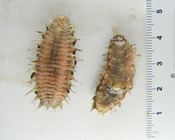RAS taxon details
Laetmonice Kinberg, 1856
129196 (urn:lsid:marinespecies.org:taxname:129196)
accepted
Genus
Laetmonice filicornis Kinberg, 1856 (type by monotypy)
- Species Laetmonice benthaliana McIntosh, 1885
- Species Laetmonice filicornis Kinberg, 1856
- Species Laetmonice producta Grube, 1877
- Species Laetmonice wyvillei McIntosh, 1885
marine, brackish, fresh, terrestrial
recent only
Kinberg, J.G.H. (1856). Nya slägten och arter af Annelider, Öfversigt af Kongl. Vetenskaps-Akademiens Förhhandlingar Stockholm, 12 (9-10), 381-388 [read 1855; printed 1856]., available online at https://www.biodiversitylibrary.org/page/15970133
page(s): 382 [details]
page(s): 382 [details]
Read, G.; Fauchald, K. (Ed.) (2021). World Polychaeta database. Laetmonice Kinberg, 1856. Accessed through: RAS (Eds.) (2021) Register of Antarctic Species at: http://ras.biodiversity.aq/aphia.php?p=taxdetails&id=129196 on 2025-09-12
RAS (Eds.) (2025). Register of Antarctic Species. Laetmonice Kinberg, 1856. Accessed at: https://ras.biodiversity.aq/aphia.php?p=taxdetails&id=129196 on 2025-09-12
Date
action
by
original description
Kinberg, J.G.H. (1856). Nya slägten och arter af Annelider, Öfversigt af Kongl. Vetenskaps-Akademiens Förhhandlingar Stockholm, 12 (9-10), 381-388 [read 1855; printed 1856]., available online at https://www.biodiversitylibrary.org/page/15970133
page(s): 382 [details]
taxonomy source Flaxman, Beth; Kupriyanova, Elena. (2024). New species of Laetmonice (Aphroditidae, Annelida) from bathyal and abyssal depths around Australia. <em>Records of the Australian Museum.</em> 76(4): 195-210., available online at https://journals.australian.museum/flaxman-2024-rec-aust-mus-764-195210/ [details] Available for editors
additional source Fauchald, K. (1977). The polychaete worms, definitions and keys to the orders, families and genera. <em>Natural History Museum of Los Angeles County: Los Angeles, CA (USA), Science Series.</em> 28:1-188., available online at http://www.vliz.be/imisdocs/publications/123110.pdf [details]
additional source Day, J. H. (1967). [Errantia] A monograph on the Polychaeta of Southern Africa. Part 1. Errantia. British Museum (Natural History), London. pp. vi, 1–458, xxix., available online at http://www.biodiversitylibrary.org/bibliography/8596 [details]
additional source Barnich, Ruth; Fiege, Dieter. (2003). The Aphroditoidea (Annelida: Polychaeta) of the Mediterranean Sea. <em>Abhandlungen der Senckenbergischen Naturforschenden Gesellschaft.</em> 559: 1-167., available online at http://www.schweizerbart.de/publications/detail/isbn/9783510613533/The-Aphroditoidea-Annelida-Polychaeta-of-the-Mediterranean-Sea [details] Available for editors
biology source Watanabe, H. K.; Uyeno, D.; Yamamori, L.; Jimi, N.; Chen, C. (2023). From commensalism to parasitism within a genus-level clade of barnacles. <em>Biology Letters.</em> 19(20220550):1-6., available online at https://doi.org/10.1098/rsbl.2022.0550
note: Occurrence of an unnamed Rhizolepas barnacle parasitizing on an unnamed Laetmonice. The host taxon genus, Laetmonice, is misspelled at every usage as Laetomonice [sic], a spelling that does not exist [details]
page(s): 382 [details]
taxonomy source Flaxman, Beth; Kupriyanova, Elena. (2024). New species of Laetmonice (Aphroditidae, Annelida) from bathyal and abyssal depths around Australia. <em>Records of the Australian Museum.</em> 76(4): 195-210., available online at https://journals.australian.museum/flaxman-2024-rec-aust-mus-764-195210/ [details] Available for editors
additional source Fauchald, K. (1977). The polychaete worms, definitions and keys to the orders, families and genera. <em>Natural History Museum of Los Angeles County: Los Angeles, CA (USA), Science Series.</em> 28:1-188., available online at http://www.vliz.be/imisdocs/publications/123110.pdf [details]
additional source Day, J. H. (1967). [Errantia] A monograph on the Polychaeta of Southern Africa. Part 1. Errantia. British Museum (Natural History), London. pp. vi, 1–458, xxix., available online at http://www.biodiversitylibrary.org/bibliography/8596 [details]
additional source Barnich, Ruth; Fiege, Dieter. (2003). The Aphroditoidea (Annelida: Polychaeta) of the Mediterranean Sea. <em>Abhandlungen der Senckenbergischen Naturforschenden Gesellschaft.</em> 559: 1-167., available online at http://www.schweizerbart.de/publications/detail/isbn/9783510613533/The-Aphroditoidea-Annelida-Polychaeta-of-the-Mediterranean-Sea [details] Available for editors
biology source Watanabe, H. K.; Uyeno, D.; Yamamori, L.; Jimi, N.; Chen, C. (2023). From commensalism to parasitism within a genus-level clade of barnacles. <em>Biology Letters.</em> 19(20220550):1-6., available online at https://doi.org/10.1098/rsbl.2022.0550
note: Occurrence of an unnamed Rhizolepas barnacle parasitizing on an unnamed Laetmonice. The host taxon genus, Laetmonice, is misspelled at every usage as Laetomonice [sic], a spelling that does not exist [details]
 Present
Present  Inaccurate
Inaccurate  Introduced: alien
Introduced: alien  Containing type locality
Containing type locality

